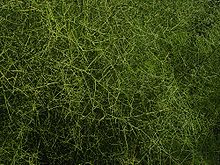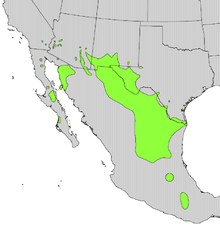
The Sonoran Desert is a North American desert and ecoregion that covers large parts of the southwestern United States, as well as the northwestern Mexican states of Sonora, Baja California, and Baja California Sur. It is the hottest desert in both Mexico and the United States. It has an area of 260,000 square kilometers (100,000 sq mi).

Cylindropuntia fulgida, the jumping cholla, also known as the hanging chain cholla, is a cholla cactus native to Sonora and the Southwestern United States.

Parkinsonia aculeata is a species of perennial flowering tree in the pea family, Fabaceae. Common names include palo verde, Mexican palo verde, Parkinsonia, Jerusalem thorn, jelly bean tree, palo de rayo, and retama.

Robinia neomexicana, the New Mexican, New Mexico, Southwest, desert, pink, or rose locust), is a shrub or small tree in the subfamily Faboideae of the family Fabaceae.

Canotia holacantha, also known as crucifixion thorn or simply canotia, is a flowering shrub / small tree in the family Celastraceae. It is the only species in the genus Canotia.
Crucifixion thorn may refer to one of the following North American desert plants:

Fraxinus velutina, the velvet ash, Arizona ash or Modesto ash, is a species of Fraxinus native to southwestern North America, in the United States from southern California east to Texas, and in Mexico from northern Baja California east to Coahuila and Nuevo León.

Psorothamnus spinosus, or Delea spinosa, is a perennial legume tree of the deserts in North America. Common names include smokethorn, smoketree, smoke tree, smokethorn dalea, and corona de Cristo.

Olneya tesota is a perennial flowering tree of the family Fabaceae, legumes, which is commonly known as ironwood, desert ironwood, or palo fierro in Spanish. It is the only species in the monotypic genus Olneya. This tree is part of the western Sonoran Desert complex in the Southwestern United States, which includes flora such as palo verde, saguaro, ocotillo, brittlebush, creosote bush, and mesquite.

Condalia globosa, also called bitter condalia, or bitter snakewood, is a perennial shrub, small tree of the family Rhamnaceae.
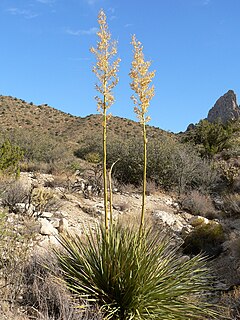
Nolina bigelovii is a flowering plant native to the Southwestern United States, California, and northwest Mexico. It grows in the driest desert areas and at elevations up to 1,500 metres (4,900 ft).

The Lower Colorado River Valley (LCRV) is the river region of the lower Colorado River of the southwestern United States in North America that rises in the Rocky Mountains and has its outlet at the Colorado River Delta in the northern Gulf of California in northwestern Mexico, between the states of Baja California and Sonora. This north–south stretch of the Colorado River forms the border between the U.S. states of California/Arizona and Nevada/Arizona, and between the Mexican states of Baja California/Sonora.

Condea emoryi, the desert lavender, is a large, multi-stemmed shrub species of flowering plant in Lamiaceae, the mint family.
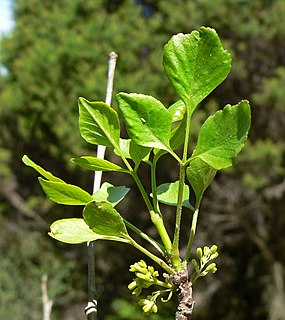
Fraxinus anomala is a species of ash tree known by the common name single-leaf ash. It is native to the southwestern United States and northern Mexico, where it grows in a number of habitats including desert scrub and chaparral. It is unusual in the genus in that some specimens have simple leaves instead of the pinnate leaves more characteristic of the group.

Celtis reticulata, with common names including netleaf hackberry, western hackberry, Douglas hackberry, netleaf sugar hackberry, palo blanco, and acibuche, is a small- to medium-sized deciduous tree native to western North America.

Quercus turbinella is a North American species of oak known by the common names shrub oak, turbinella oak, shrub live oak, and gray oak. It is native to Arizona, California, New Mexico, Utah, Colorado, and Nevada in the western United States. It also occurs in northern Mexico.

Yucca faxoniana is a bladed evergreen shrub of the genus Yucca. It is known by the common names Faxon yucca,Spanish dagger, and giant dagger.

Yucca × schottii is a plant species in the genus Yucca, native to southern Arizona, southwestern New Mexico, and the northern parts of Sonora and Chihuahua. The common names are Schott's yucca, hoary yucca, and mountain yucca. The "×" in the name indicates that this is a nothospecies, regarded as being a natural hybrid between two other species. In this case, Yucca × schottii is believed to have originated as a hybrid between Y. baccata and Y. madrensis. Yucca × schottii is firmly established and does reproduce freely in the wild.
Eysenhardtia orthocarpa is a species of small flowering tree, in the family Fabaceae. Its range is at the northern region of the Sierra Madre Occidental cordillera of eastern Sonora; it is also in central Sonora, with the species ranging into southeast Arizona and the extreme southwest, bootheel region of New Mexico, the entire sky island region at the northern cordillera called Madrean Sky Islands.
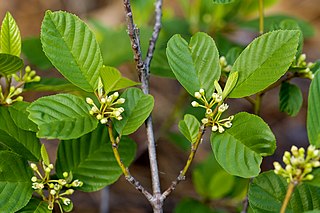
Frangula betulifolia, the birchleaf buckthorn, is a shrub or small tree in the buckthorn family, Rhamnaceae. It is native in northern Mexico in the Sierra Madre Occidental cordillera, and mountainous, desert regions of the Southwestern United States of Arizona, Utah, New Mexico, and far west Texas; besides being found in Sonora, Chihuahua and Durango of the Occidental cordillera, a large species locale occurs to the east in Nuevo León.
